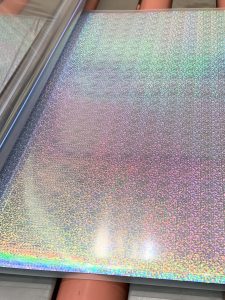People often confuse iridescence and holographic features when discussing them. However, there is a fundamental distinction between these two colour shifting terms. Let’s look at both in detail to see what the facts are. Then, if you need foiling services, we can provide them for you.
Iridescent
This is the gradual shift of colours when looking at an exterior from individual angles. There are a lot of properties that do this. For instance, there is luminescent, pearlescent, and opalescent. All of them use the same principle for colour shifting. Here the colours gradually change when the angle of illumination or view changes.
How does iridescence happen?
The two ways iridescence occurs are either diffraction or interference. The latter is the small selection of colour changing on an exterior based on available light. Diffraction is the full range of rainbow shades shown from all angles. The colours found in an oil slick, bubble, or on peacock feathers are able to interfere with another form, generating the colour effects. Other iridescence examples would be optically anisotropic effects when individual optical light properties have separate directions.
Holographic
 Here we have holograms. These are photographic records that stop light from scattering from an area without special lenses. There are many holographic techniques that exist. Examples include security labels that are rainbow holographic. Or, there are objects you’re able to shine a light straight through to view the other side. This is transmitted holographic. We make extensive use of holographic foils in our foiling services. If you’d like to use them, please let us know.
Here we have holograms. These are photographic records that stop light from scattering from an area without special lenses. There are many holographic techniques that exist. Examples include security labels that are rainbow holographic. Or, there are objects you’re able to shine a light straight through to view the other side. This is transmitted holographic. We make extensive use of holographic foils in our foiling services. If you’d like to use them, please let us know.
Light would need to shine straight through a holographic item for an object to have the 3D effect. The item would need a clear area for light beams to interact. Also, the material would need to be decent enough so we could see the image.
The light beam divides into two distinct forms of light. There is an object beam and an illuminating beam. You direct both into the item. The beams interfere and interact with each other. Such action produces a pattern into the recording medium, generating a holographic image.
Using iridescent and holographic in the marketplace
Let’s end by talking about how people use the words iridescent and holographic in the marketplace. For makeup product description boxes, they use the words to refer to the vibrancy of colours. They’d both be rainbow coloured and colour shifting prisms. Yet, there is a difference between the softly saturated or deeply vibrant. The vibrancy of colours makes a huge difference when discussing depth.
Iridescent goods need to show a simple display of the colours changing from a colour hue to a lighter glowing colour. When an item is moving to reveal the colour changing attributes, it would reveal the adjusted hue and tint of that item to you. An iridescent item can seem to have a colour or glow become lighter inside a hue. The product would seem flat as well since there’s no depth perception to see its form.
As for the holographic effect, you get it with the vivid use of light for highlighting areas. Holographic items are likely to have a rainbow effect. Or, they’ll come with a full view of the colour spectrum when the substance is in light. It would generate visible dimensions or depth to an item when you curve it.
Work with us and choose foiling service with stunning effects
At Foiling Services, we use state of the art equipment to do our work. This allows us to use a host of foils, including holographic, silver, gold, mirror, and more. Whatever it is you want us to do, we’ll achieve it.
So, feel free to get in touch anytime to find out what our foiling services can do for you. They are great for makeup packaging, POS items, and much more.
